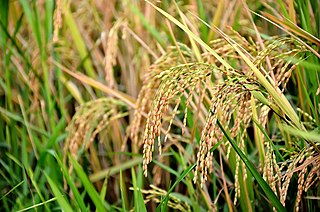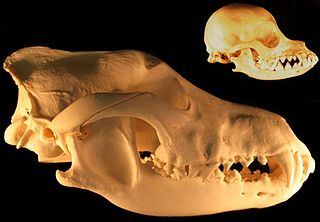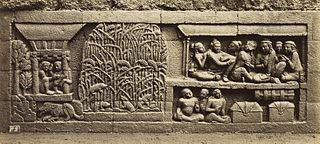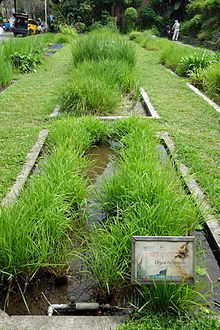
Rice is a cereal grain, and in its domesticated form is the staple food for over half of the world's human population, particularly in Asia and Africa, due to the vast amount of soil that is able to grow rice. Rice is the seed of the grass species Oryza sativa or, much less commonly, O. glaberrima. Asian rice was domesticated in China some 13,500 to 8,200 years ago, while African rice was domesticated in Africa some 3,000 years ago. Rice has become commonplace in many cultures worldwide; in 2021, 787 million tons were produced, placing it fourth after sugarcane, maize, and wheat. Only some 8% of rice is traded internationally. China, India, and Indonesia are the largest consumers of rice. A substantial amount of the rice produced in developing nations is lost after harvest through factors such as poor transport and storage. Rice yields can be reduced by pests including insects, rodents, and birds, as well as by weeds, and by diseases such as rice blast. Traditional rice polycultures such as rice-duck farming, and modern integrated pest management seek to control damage from pests in a sustainable way.

Oryza is a genus of plants in the grass family. It includes the major food crop rice. Members of the genus grow as tall, wetland grasses, growing to 1–2 metres (3–7 ft) tall; the genus includes both annual and perennial species.

Oryza sativa is the most common of the two rice species cultivated as a cereal, the other species being O. glaberrima, African rice. It was first domesticated in the Yangtze River basin in China 13,500 to 8,200 years ago.

In plant biology, Vavilovian mimicry is a form of mimicry in plants where a weed evolves to share one or more characteristics with a domesticated plant through generations of artificial selection. It is named after Nikolai Vavilov, a prominent Russian plant geneticist. Selection against the weed may occur by killing a young or adult weed, separating its seeds from those of the crop (winnowing), or both. This has been done manually since Neolithic times, and in more recent years by agricultural machinery.

Oryza barthii, also called Barth's rice, wild rice, or African wild rice, is a grass in the rice genus Oryza. It is an annual, erect to semierect grass. It has leaves with a short ligule, and panicles that are compact to open, rarely having secondary branching. The inflorescence structure are large spikelets, 7.7–12.3 millimetres long and 2.3–3.5 millimetres wide, with strong awns, usually red. The inflorescences have anthers 1.5–3 millimetres long.

Oryza longistaminata is a perennial species of grass from the same genus as cultivated rice. It is native to most of sub-Saharan Africa and Madagascar. It has been introduced into the United States, where it is often regarded as a noxious weed. Its common names are longstamen rice and red rice.

A crop wild relative (CWR) is a wild plant closely related to a domesticated plant. It may be a wild ancestor of the domesticated (cultivated) plant or another closely related taxon.

Oryza glaberrima, commonly known as African rice, is one of the two domesticated rice species. It was first domesticated and grown in West Africa around 3,000 years ago. In agriculture, it has largely been replaced by higher-yielding Asian rice, and the number of varieties grown is declining. It still persists, making up an estimated 20% of rice grown in West Africa. It is now rarely sold in West African markets, having been replaced by Asian strains.
Oryza nivara is a wild progenitor of the cultivated rice Oryza sativa. It is found growing in swampy areas, at edge of pond and tanks, beside streams, in ditches, in or around rice fields. Grows in shallow water up to 0.3 metres, in seasonally dry and open habitats.

Rice production in China is the amount of rice planted, grown, and harvested for consumption in the mainland of China.

Perennial rice are varieties of long-lived rice that are capable of regrowing season after season without reseeding; they are being developed by plant geneticists at several institutions. Although these varieties are genetically distinct and will be adapted for different climates and cropping systems, their lifespan is so different from other kinds of rice that they are collectively called perennial rice. Perennial rice—like many other perennial plants—can spread by horizontal stems below or just above the surface of the soil but they also reproduce sexually by producing flowers, pollen and seeds. As with any other grain crop, it is the seeds that are harvested and eaten by humans.

Aeschynomene americana is a species of flowering plant in the family Fabaceae (legume) known by many common names, including shyleaf, forage aeschynomene, American joint vetch, thornless mimosa, bastard sensitive plant (Jamaica), pega pega, pega ropa, antejuela, ronte, cujicillo, and dormilonga. It is native to Central America, parts of South America, the West Indies, and Florida. It is now found in the US, in Australia and in South-East Asia.
Oryza brachyantha is a grass in the rice genus Oryza, distantly related to cultivated rice O. sativa, and native to tropical Africa. It is an annual grass that grows as a tuft.
Oryza punctata is an annual grass in the rice genus Oryza, also known as red rice, related to cultivated rice O. sativa. O. punctata forms clumps or tussocks from 50–120 cm tall. It is a native to tropical Africa and Madagascar but is also found in Thailand and other parts of Indochina. O. punctata is a weed species in commercial rice growing operations although it appears to be rare in its native range. O. punctata has an IUCN status of least concern. It is not generally eaten or used as fodder by farmers but there is some evidence that it has been used as such during periods of famine. Due to the importance of the crop varieties of rice globally, the evolution of the Oryza genus as a whole has been studied extensively. A lot of information about O. punctata has been elucidated as a secondary benefit to this commercial research. O. punctata evolved some 5 million years ago in the second of two rapid radiation events that occurred in the Oryza L. genus.

Xanthomonas oryzae pv. oryzae is a bacterial pathovar that causes a serious blight of rice, other grasses, and sedges.

Domestication syndrome refers to two sets of phenotypic traits that are common to either domesticated plants or domesticated animals.
Oryza officinalis is species of flowering plant in the genus Oryza (rice) native to India, Nepal, the eastern Himalaya, southeast Asia, south-central and southeast China, Hainan, the Philippines, New Guinea, and the Northern Territory and Queensland in Australia. A perennial diploid with the CC rice genome, it can reach 3 m (10 ft) in height. It is the namesake of a widespread species complex.

The history of rice cultivation is an interdisciplinary subject that studies archaeological and documentary evidence to explain how rice was first domesticated and cultivated by humans, the spread of cultivation to different regions of the planet, and the technological changes that have impacted cultivation over time.
The agricultural weed syndrome is the set of common traits which make a plant a successful agricultural weed. Most of these traits are not, themselves, phenotypes but are instead methods of rapid adaptation. So equipped, plants of various origins - invasives, natives, mildly successful marginal weeds of agriculture, weeds of other settings - accumulate other characteristics which allow them to compete in an environment with a high degree of human management.
In biology, parallel speciation is a type of speciation where there is repeated evolution of reproductively isolating traits via the same mechanisms occurring between separate yet closely related species inhabiting different environments. This leads to a circumstance where independently evolved lineages have developed reproductive isolation from their ancestral lineage, but not from other independent lineages that inhabit similar environments. In order for parallel speciation to be confirmed, there is a set of three requirements that has been established that must be met: there must be phylogenetic independence between the separate populations inhabiting similar environments to ensure that the traits responsible for reproductive isolation evolved separately, there must be reproductive isolation not only between the ancestral population and the descendent population, but also between descendent populations that inhabit dissimilar environments, and descendent populations that inhabit similar environments must not be reproductively isolated from one another. To determine if natural selection specifically is the cause of parallel speciation, a fourth requirement has been established that includes identifying and testing an adaptive mechanism, which eliminates the possibility of a genetic factor such as polyploidy being the responsible agent.
















